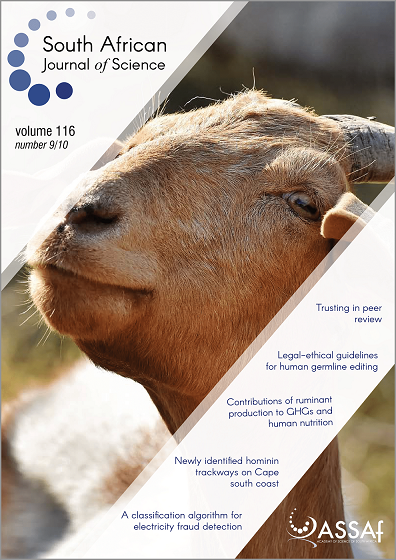Forest product harvesting in the Eastern Cape, South Africa: Impacts on habitat structure
DOI:
https://doi.org/10.17159/sajs.2020/7508Keywords:
medicinal bark harvesting, timber harvesting, pole harvesting, habitat degradation, habitat modificationAbstract
The Eastern Cape Province harbours 46% of South Africa’s remaining indigenous forest cover, and is one of the country’s poorest and least developed provinces. Forest resources thus represent a vital component of rural livelihoods in this region. Consequently, forest management policies aim to balance the needs of resource users with the ecological integrity of forest ecosystems. In a recent study, forest bird ranges were shown to have declined in the Eastern Cape over the past 20 years, despite increases in forest cover over the same time period, indicating that habitat degradation may be driving forest bird losses. Given that harvesting of forest products represents the primary human disturbance in forests in the Eastern Cape today, insight is needed regarding the link between resource use and habitat modification. We report on effects of harvesting of three key forest products – poles, timber and medicinal bark – on habitat structure at the ground, understorey and canopy layers in indigenous forests in the province. Harvest activities had considerable impacts on habitat structure, depending on the nature and extent of harvesting. Bark and timber harvesting resulted in canopy gaps, whereas pole harvesting reduced tree density, resulting in understorey gaps. Overall, harvest activities increased the frequency of canopy disturbance, and density of understorey layer foliage. Unsustainable bark harvesting practices increased the mortality rate of canopy trees, thereby increasing dead wood availability. By providing insight into human-mediated habitat modification in forests of the Eastern Cape, this study contributes to the development of ecologically informed sustainable resource management policies.
Significance:
- Unregulated harvesting of forest products in state-managed indigenous forests of the Eastern Cape results in habitat modification.
- The nature and extent of habitat modification is dependent on the type and intensity of resource use, indicating that resource use may be sustainably managed.
- Timber and medicinal bark harvesting activities result in canopy disturbances, thereby altering natural canopy gap dynamics, with concomitant impacts on understorey habitat structure.
- Changes in forest habitat structure associated with high levels of resource use are likely to have ramifying effects on forest biodiversity.
Published
Issue
Section
License

All articles are published under a Creative Commons Attribution 4.0 International Licence
Copyright is retained by the authors. Readers are welcome to reproduce, share and adapt the content without permission provided the source is attributed.
Disclaimer: The publisher and editors accept no responsibility for statements made by the authors
How to Cite
- Abstract 911
- PDF 831
- EPUB 193
- XML 347
Funding data
-
National Research Foundation
Grant numbers FBIP 98871












.png)